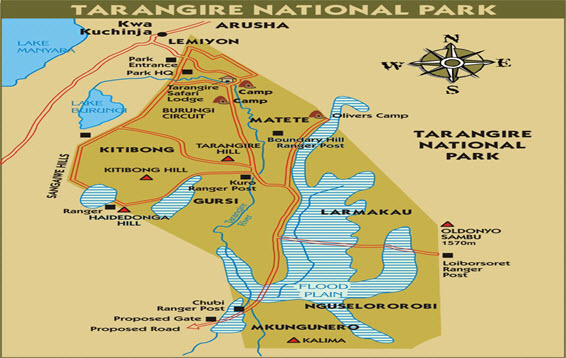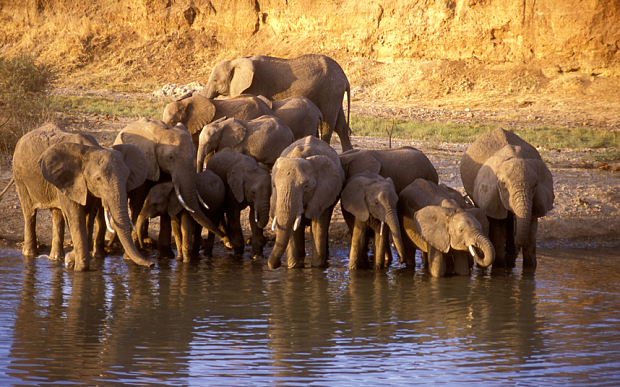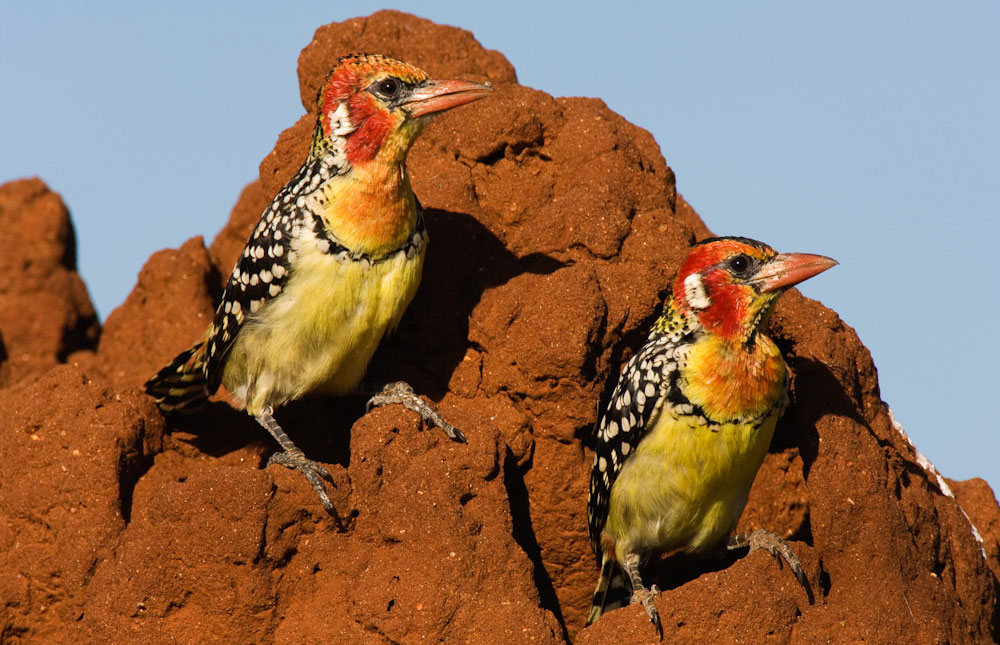

Tarangire N. Park – Size: 2850 km² / 1096 mi² – Altitude: 982-1646 m / 3222-5400 ft
Tarangire is one of the more seasonal parks in northern Tanzania with a lot of migratory movement within the greater Tarangire ecosystem. In the dry season, between June and October, large herds of animals are attracted to the Tarangire River. At this time, the elephant numbers are spectacular. The park should be part of any safari in northern Tanzania.

The fierce sun sucks the moisture from the landscape, baking the earth a dusty red, the withered grass as brittle as straw. The Tarangire River has shriveled to a shadow of its wet season self. But it is choked with wildlife. Thirsty nomads have wandered hundreds of parched kilometers knowing that here, always, there is water. Herds of up to 300 elephants scratch the dry river bed for underground streams, while migratory wildebeest, zebra, buffalo, impala, gazelle, Hartebeest and eland crowd the shrinking lagoons. It’s the greatest concentration of wildlife outside the Serengeti ecosystem – a smorgasbord for predators – and the one place in Tanzania where dry-country antelope such as the stately fringe-eared Oryx and peculiar long-necked Gerenuk are regularly observed.

During the rainy season, the seasonal visitors scatter over a 20,000 sq km (12,500 sq miles) range until they exhaust the green plains and the river calls once more. But Tarangire mobs of elephant are easily encountered, wet or dry. The swamps, tinged green year round, are the focus for 550 bird varieties, the most breeding species in one habitat anywhere in the world. On drier ground you find the Kory bastard, the heaviest flying bird; the stocking-thighed ostrich, the world’s largest bird; and small parties of ground horn-bills blustering like turkeys. More ardent bird-lovers might keep an eye open for screeching flocks of the dazzlingly colorful yellow-collared lovebird, and the somewhat drabber rufous-tailed weaver and ashy starling – all endemic to the dry Savannah of north-central Tanzania.

Disused termite mounds are often frequented by colonies of the endearing dwarf mongoose, and pairs of red-and-yellow barbet, which draw attention to themselves by their loud, clockwork-like duet ting. Tarangire pythons climb trees, as do its lions and leopards, lounging in the branches where the fruit of the sausage tree disguises the twitch of a tail.
Pros and Cons
Top general wildlife viewing in the dry season
Incredible concentration of elephants in the dry season
Excellent birding with many dry-country specials
Stunning scenery with many baobab trees
Excellent mid-range and luxury lodges
It gets crowded during peak season (June to October)
Animals are scattered in the wet season
Wildlife
Herds of up to 300 elephants can be found, looking for underground streams, in the dry riverbeds while migratory wildebeest, zebra, buffalo, impala, gazelle, hartebeest and eland crowd the shrinking lagoons. Dry-country antelope such as fringe-eared oryx and the long-necked gerenuk are also regularly spotted. Abandoned termite-mounds often house mongoose colonies. All the main predators are present but, because of thick vegetation, not spotted as often as in some of the other parks in northern Tanzania.
Scenery
The park’s dominant feature is the Tarangire River. Although it gets very dry, the park is relatively thickly vegetated with acacia shrubs and mixed woodland. Most memorable of which are the huge baobab trees dotted around in big numbers.









